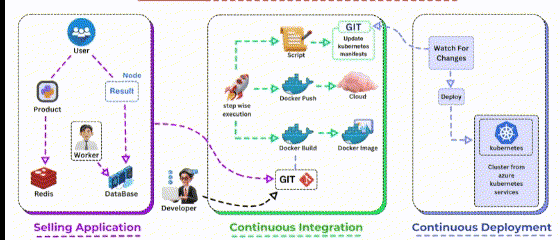What is a CI/CD pipeline?
A CI/CD pipeline is a set of processes that automates the building, testing, and deployment of software changes. The pipeline is designed to ensure that each code change goes through a series of automated tests and validations before it is deployed to production
In this overview, we delve deeper into the Azure CI/CD Pipeline, outlining its core components, workflow, and key benefits for cloud-based software delivery.
Key Components of Azure CI/CD Pipeline:
- Selling Application:
Description: The main web-based platform where users interact with and showcase products.
Role: Acts as the cornerstone of the architecture, ensuring seamless user experience and interaction.
- Redis:
Description: An in-memory data store.
Role: Facilitates caching and persistence by storing product results, thereby improving performance and reliability.
- Kubernetes and Azure Kubernetes Service (AKS):
Description: Kubernetes automates the deployment, scaling, and management of containerized applications. AKS is Microsoft’s managed Kubernetes service.
Role: Hosts Kubernetes clusters essential for deploying the selling application across multiple servers, ensuring consistent and scalable operations.
- Continuous Integration and Continuous Delivery (CI/CD):
Description: Automates the building, testing, and deployment processes.
Role: Backbone of the pipeline, enabling faster release cycles and maintaining high-quality code through automated workflows.
Workflow of Azure CI/CD Pipeline:
- Development Phase:
Version Control: Developers use Git to manage code versions, ensuring collaborative and organized development.
Docker Images: Applications and their dependencies are packaged into Docker images for a consistent deployment environment.
Continuous Integration: Scripts automate the build, test, and push processes, creating Docker images ready for deployment.
- Deployment Phase:
Monitoring: The Azure CI/CD Pipeline monitors the codebase for changes.
Triggering Deployments: Upon detecting changes, the pipeline triggers the deployment process.
Orchestrating Deployment: Kubernetes manifests guide the deployment of the selling application to the AKS cluster.
Rolling Updates: Ensures minimal downtime and maximum efficiency by rolling out updates seamlessly.

Benefits of Azure CI/CD Pipeline:
- Automation:
Efficiency: Automates repetitive tasks such as building, testing, and deployment, allowing developers to focus on innovation.
Consistency: Ensures consistent processes, reducing human error.
- Scalability:
Adaptability: Leverages Kubernetes and AKS to scale applications effortlessly, meeting growing demands without compromising performance.
- Reliability:
Quality Assurance: Automated testing and continuous monitoring ensure high-quality software delivery, minimizing errors and glitches.
- Security:
Protection: Azure’s robust security features, combined with CI/CD best practices, protect the pipeline against potential threats, safeguarding sensitive data and ensuring compliance with industry standards.
Summary:
The Azure CI/CD Pipeline offers a comprehensive solution for modern software delivery, enhancing efficiency, scalability, reliability, and security in the cloud.


